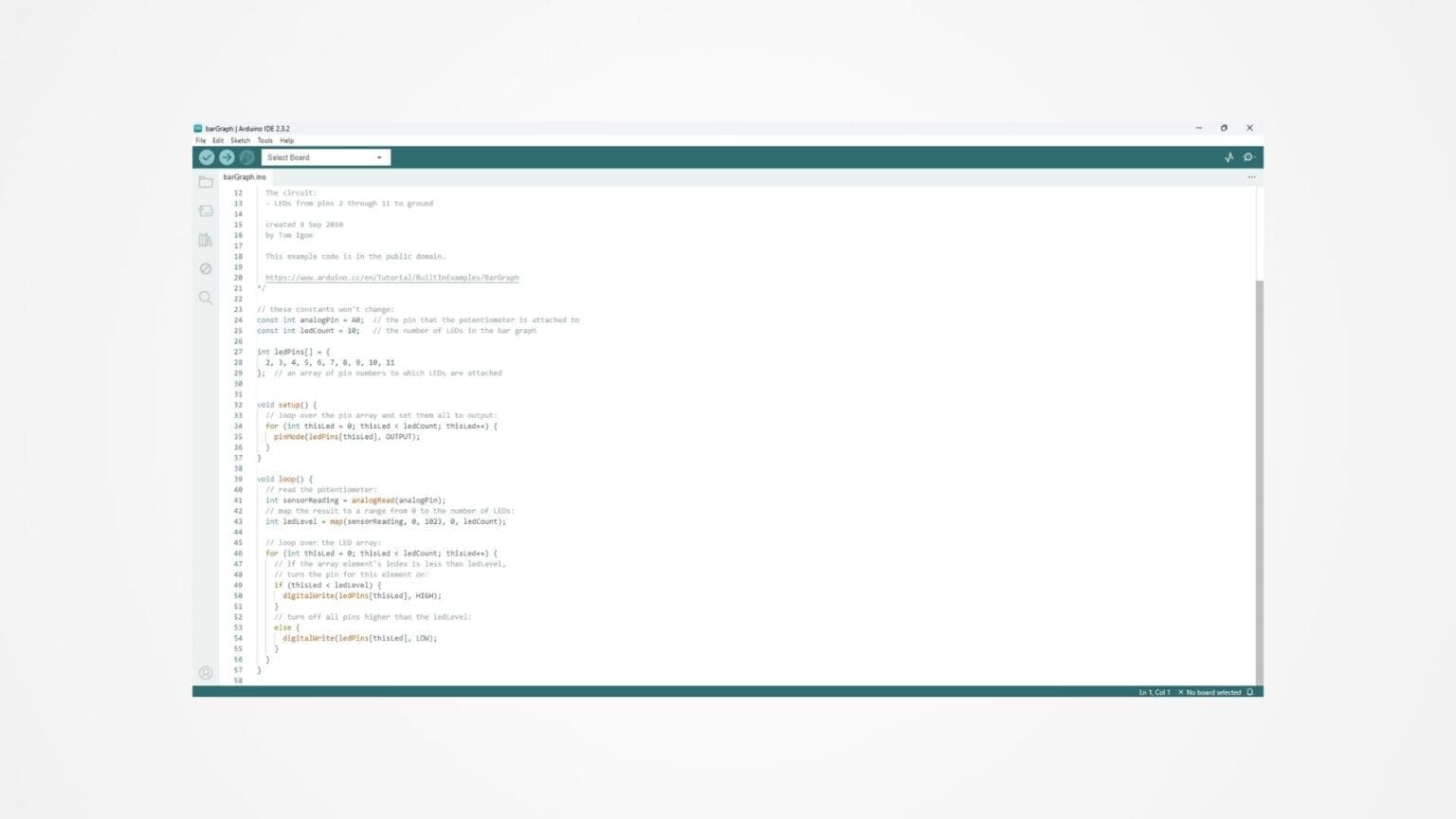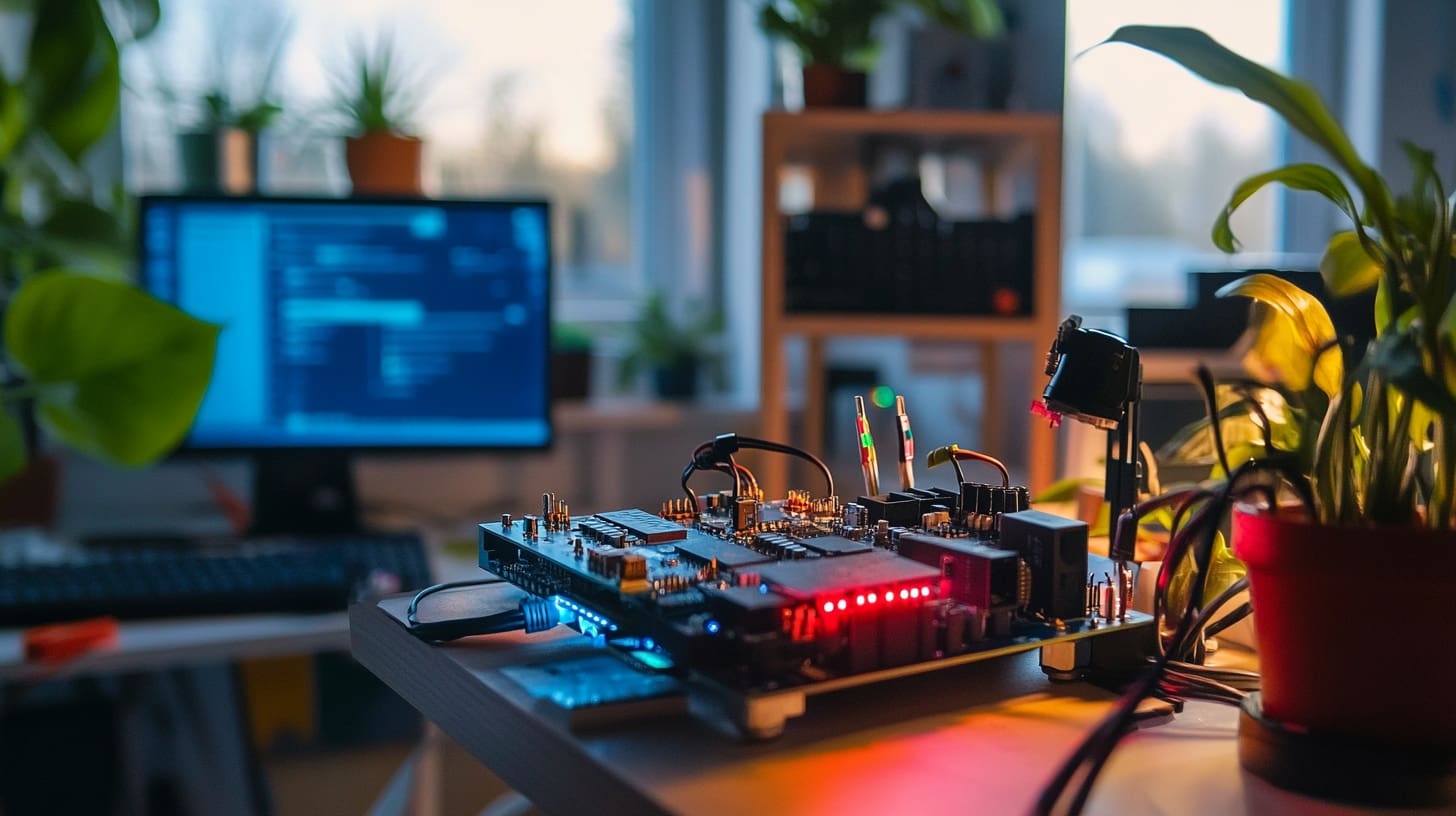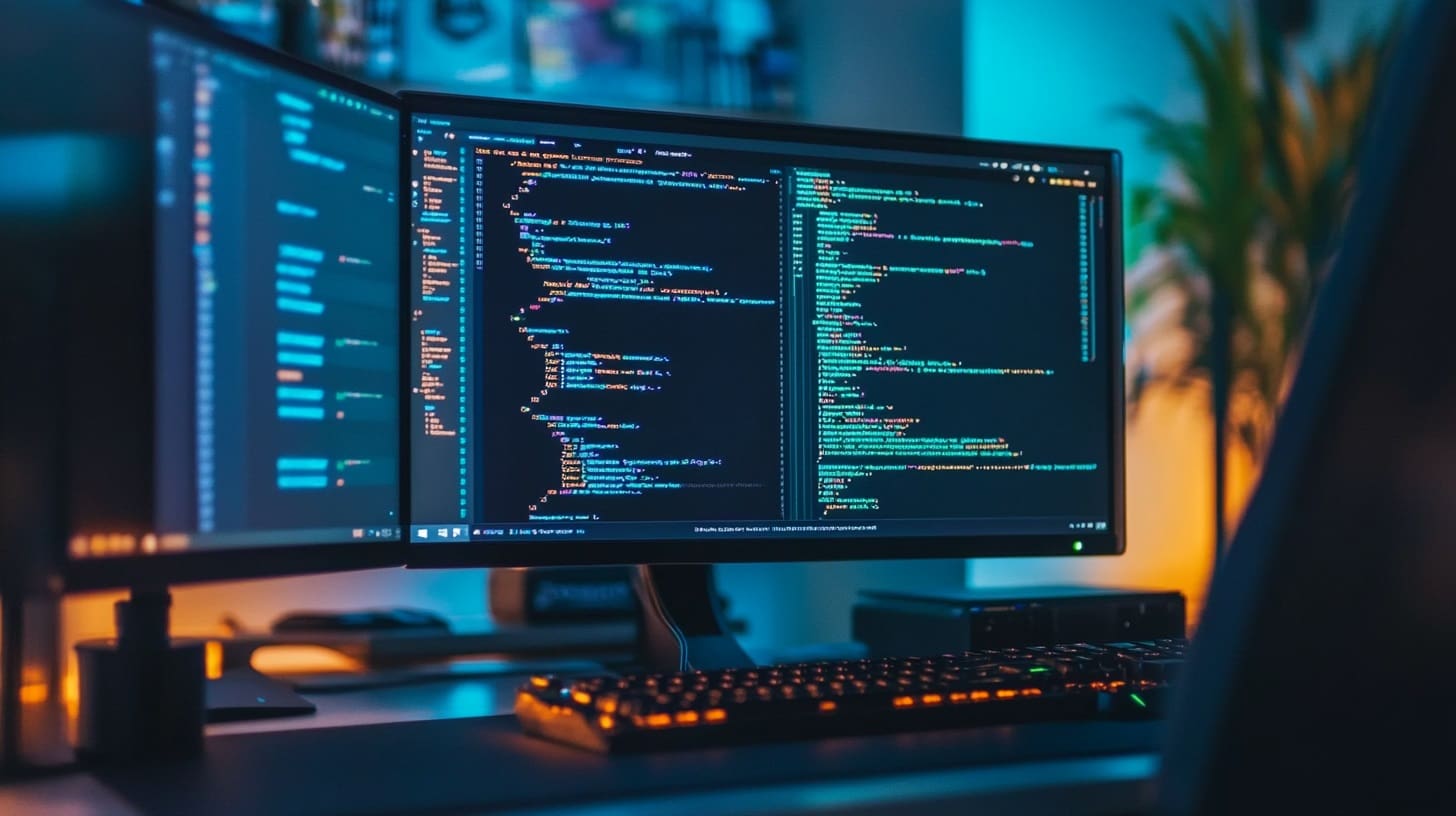Arduino is one of the most accessible platforms for learning electronics and programming. At the heart of every Arduino project is the code, known as a “sketch,” which is written using a simplified version of C/C++ programming language. Understanding the syntax and structure of Arduino code is crucial for creating functional projects, whether you’re blinking an LED, reading sensor data, or controlling a complex robot.
This guide will introduce you to the basics of Arduino programming, covering the essential syntax, structure, and key functions that form the foundation of every Arduino sketch. By the end of this guide, you’ll have a solid understanding of how Arduino code works, enabling you to write your own sketches with confidence.
Basic Structure of an Arduino Sketch
Every Arduino program, or sketch, follows a simple and consistent structure that makes it easy to get started. The basic structure consists of two main functions: setup() and loop(). These functions are the core of every Arduino sketch and control the flow of the program.
1. The setup() Function
The setup() function is called once when your Arduino board is powered on or reset. It’s used to initialize settings, such as configuring input and output pins, starting serial communication, or setting up libraries. Think of setup() as the part of your code that prepares the Arduino to run the main program.
Example of the setup() Function:
void setup() {
pinMode(13, OUTPUT); // Set pin 13 as an output
Serial.begin(9600); // Start serial communication at 9600 baud
}In this example:
pinMode(13, OUTPUT);configures digital pin 13 as an output, which could be used to control an LED.Serial.begin(9600);initializes serial communication, allowing the Arduino to send and receive data via the Serial Monitor.
2. The loop() Function
The loop() function runs continuously after the setup() function completes. It’s where the main code resides, executing repeatedly for as long as the Arduino is powered. This function is ideal for tasks that need to be repeated, such as reading sensor data, controlling motors, or updating a display.
Example of the loop() Function:
void loop() {
digitalWrite(13, HIGH); // Turn on the LED on pin 13
delay(1000); // Wait for one second
digitalWrite(13, LOW); // Turn off the LED
delay(1000); // Wait for one second
}In this example:
digitalWrite(13, HIGH);sets pin 13 to a HIGH state, turning on the connected LED.delay(1000);pauses the program for 1000 milliseconds (1 second).- The code inside
loop()runs over and over, creating a blinking effect.
Together, setup() and loop() form the backbone of any Arduino sketch, allowing you to control when and how your code executes.
Basic Arduino Syntax and Commands
Understanding the basic syntax and common commands of Arduino programming is essential for writing functional code. Here are some key components:
1. Comments
Comments are lines of text in the code that are ignored by the Arduino when compiling. They are used to explain code, making it easier to understand and maintain. There are two types of comments in Arduino:
- Single-line comments start with
//. Anything following//on that line is considered a comment.
// This is a single-line comment
int ledPin = 13; // Define pin 13 as ledPin- Multi-line comments start with
/*and end with*/. They can span multiple lines.
/*
This is a multi-line comment.
It can be used to explain a section of code.
*/2. Variables and Data Types
Variables store data that your Arduino sketch uses. They have names, types, and values. Understanding variables and data types is crucial because they dictate what kind of information you can store and manipulate.
- Declaring Variables: You declare a variable by specifying its type followed by its name.
int counter = 0; // Declare an integer variable named counter- Common Data Types:
int: Stores integers (whole numbers), e.g.,int num = 10;.float: Stores floating-point numbers (decimals), e.g.,float voltage = 5.75;.char: Stores single characters, e.g.,char letter = 'A';.bool: Stores Boolean values (trueorfalse), e.g.,bool isOn = true;.String: Stores text strings, e.g.,String name = "Arduino";.
3. Functions
Functions are blocks of code designed to perform specific tasks. In Arduino, functions help organize your code, making it easier to read and debug.
- Built-in Functions: Arduino provides many built-in functions, such as:
pinMode(pin, mode);: Configures a pin as an input or output.digitalWrite(pin, value);: Sets a pin to HIGH or LOW.digitalRead(pin);: Reads the state of a digital input pin (HIGH or LOW).analogRead(pin);: Reads the value from an analog input pin (0 to 1023).analogWrite(pin, value);: Writes an analog value (PWM) to a pin (0 to 255).
- User-defined Functions: You can create your own functions to perform repetitive tasks or simplify complex code
Example of a User-defined Function:
void blinkLed() {
digitalWrite(13, HIGH); // Turn the LED on
delay(500); // Wait for 500 milliseconds
digitalWrite(13, LOW); // Turn the LED off
delay(500); // Wait for 500 milliseconds
}
void loop() {
blinkLed(); // Call the blinkLed function
}In this example, the blinkLed() function encapsulates the code to blink an LED, making loop() cleaner and easier to manage.
4. Control Structures
Control structures allow you to control the flow of your program based on conditions and loops. The most common control structures in Arduino programming include if, else, for, and while.
ifandelseStatements: Used for conditional execution. If the condition is true, the code inside theifblock runs; otherwise, theelseblock runs.
int sensorValue = analogRead(A0);
if (sensorValue > 500) {
digitalWrite(13, HIGH); // Turn on LED if sensorValue is greater than 500
} else {
digitalWrite(13, LOW); // Turn off LED otherwise
}forLoop: Executes a block of code a specific number of times, often used for iterating over arrays or repeating actions.
for (int i = 0; i < 10; i++) {
digitalWrite(13, HIGH);
delay(200);
digitalWrite(13, LOW);
delay(200);
}whileLoop: Repeats a block of code while a specified condition is true.
while (digitalRead(7) == LOW) {
// Continue looping until the button on pin 7 is pressed
digitalWrite(13, HIGH);
}Control structures provide the logic that drives how your Arduino responds to inputs and executes tasks, making them essential for creating interactive and dynamic projects.
5. Operators
Operators are symbols that perform operations on variables and values. They are used for arithmetic, comparisons, and logical operations.
- Arithmetic Operators:
+,-,*,/,%(addition, subtraction, multiplication, division, modulus). - Comparison Operators:
==,!=,<,>,<=,>=(equal, not equal, less than, greater than, less than or equal to, greater than or equal to). - Logical Operators:
&&,||,!(and, or, not).
Example Using Operators:
int a = 5;
int b = 10;
int c = a + b; // Arithmetic: c is 15
bool isEqual = (a == b); // Comparison: isEqual is false
bool isBoth = (a < b && b > 0); // Logical: isBoth is trueUnderstanding these operators helps you manipulate data and create complex logic in your sketches.
Common Arduino Programming Mistakes and Tips
As a beginner, it’s easy to make simple mistakes when writing Arduino code. Here are some common pitfalls and tips to avoid them:
- Missing Semicolons: Every statement in Arduino code should end with a semicolon (
;). Missing semicolons are a frequent source of compilation errors. - Incorrect Pin Modes: Always set your pin modes correctly in
setup(). Forgetting to set a pin as an output or input can cause unexpected behavior. - Overusing
delay(): Thedelay()function pauses your program and blocks other code from running. Use it sparingly, and consider alternatives likemillis()for non-blocking timing. - Variable Scope Issues: Variables declared inside a function are local to that function and cannot be accessed outside of it. Use global variables when needed across different functions.
Mastering the basics of Arduino syntax and structure is your first step toward creating complex, interactive projects. With these foundational skills, you can begin to explore more advanced programming techniques and expand your understanding of what Arduino can do.
Diving Deeper into Arduino Programming: Functions, Libraries, and Error Handling
Creating and Using Functions in Arduino
Functions are an essential part of programming that help you organize your code, make it more readable, and avoid repetition. In Arduino, functions allow you to break down complex tasks into smaller, manageable pieces, improving both the structure and efficiency of your sketches.
1. Defining Your Own Functions
Creating your own functions allows you to encapsulate specific actions or calculations that you may need to perform multiple times within your sketch. Each function typically consists of a return type, a name, parameters (optional), and the function body.
Basic Structure of a Function:
returnType functionName(parameters) {
// Function body: code to be executed
}returnType: Specifies the type of value the function returns, such asint,float,void(if no value is returned), etc.functionName: A unique name that describes the function’s purpose.parameters: Optional inputs that the function needs to perform its task. Parameters are enclosed in parentheses.- Function Body: The code inside curly braces
{}that runs when the function is called.
Example: Creating a Function to Calculate the Sum of Two Numbers
int sum(int a, int b) {
int result = a + b; // Calculate the sum of a and b
return result; // Return the result to where the function was called
}
void setup() {
Serial.begin(9600); // Start serial communication
int total = sum(5, 10); // Call the sum function with arguments 5 and 10
Serial.println(total); // Print the result (15)
}
void loop() {
// Empty loop
}In this example:
- The
sum()function takes two integer parameters (aandb), calculates their sum, and returns the result. - Functions like
sum()can be reused multiple times throughout your sketch, making your code cleaner and more organized.
2. Using Functions to Reduce Code Complexity
Functions are particularly useful when dealing with repetitive tasks. For instance, if you are controlling multiple LEDs with similar behavior, creating a function to handle the blinking process can save time and reduce errors.
Example: Blinking Multiple LEDs Using a Function
// Define LED pins
const int led1 = 8;
const int led2 = 9;
const int led3 = 10;
void setup() {
// Initialize LED pins as outputs
pinMode(led1, OUTPUT);
pinMode(led2, OUTPUT);
pinMode(led3, OUTPUT);
}
// Function to blink an LED for a specified duration
void blinkLed(int ledPin, int duration) {
digitalWrite(ledPin, HIGH); // Turn on the LED
delay(duration); // Wait for the specified time
digitalWrite(ledPin, LOW); // Turn off the LED
delay(duration); // Wait for the specified time
}
void loop() {
blinkLed(led1, 500); // Blink LED 1
blinkLed(led2, 300); // Blink LED 2 with a shorter duration
blinkLed(led3, 700); // Blink LED 3 with a longer duration
}This approach allows you to control multiple LEDs with different blink rates while keeping your loop() function concise and easy to read.
Exploring Arduino Libraries
Libraries are collections of pre-written code that provide extra functionality for your Arduino projects. They simplify the process of interacting with sensors, displays, motors, and other peripherals, allowing you to focus on your application rather than writing low-level code from scratch.
1. What Are Libraries and Why Use Them?
Libraries save you time by providing tested, reusable code blocks that handle specific tasks. For example, instead of writing complex code to control a servo motor, you can use the Servo library, which simplifies motor control with just a few function calls.
Commonly Used Libraries:
- Servo: Used for controlling servo motors with precise angle adjustments.
- Wire: Facilitates communication with I2C devices, such as LCD displays and sensors.
- SPI: Manages communication with SPI devices, including SD cards and some sensors.
- LiquidCrystal: Simplifies interfacing with LCD displays for text output.
- Adafruit Sensor Libraries: Provides easy integration with a variety of sensors from Adafruit.
2. How to Include Libraries in Your Sketch
Libraries can be included in your Arduino sketch using the #include directive at the beginning of your code. You can add libraries manually or use the Library Manager in the Arduino IDE to install them.
Installing and Including a Library:
- Open the Arduino IDE.
- Go to Sketch > Include Library > Manage Libraries… to open the Library Manager.
- Search for the library you need (e.g., Servo) and click “Install.”
- Include the library in your sketch by adding
#includeat the top of your code.
Example: Using the Servo Library to Control a Servo Motor
#include <Servo.h> // Include the Servo library
Servo myServo; // Create a Servo object
void setup() {
myServo.attach(9); // Attach the servo to pin 9
}
void loop() {
myServo.write(0); // Move the servo to 0 degrees
delay(1000); // Wait one second
myServo.write(90); // Move the servo to 90 degrees
delay(1000); // Wait one second
myServo.write(180); // Move the servo to 180 degrees
delay(1000); // Wait one second
}In this code:
- The
Servolibrary manages all the complex code required to control the servo motor, allowing you to move the servo with simple commands likewrite().
Error Handling in Arduino Programming
Writing code often involves errors, especially when you’re learning or working on complex projects. Understanding common errors and how to debug them can help you resolve issues quickly.
1. Compilation Errors
Compilation errors occur when your code doesn’t follow the proper syntax, causing the Arduino IDE to fail to convert your sketch into machine-readable code. These errors are usually displayed at the bottom of the IDE.
Common Compilation Errors:
- Missing Semicolons: Every line of code that performs an action must end with a semicolon (
;). Missing semicolons are one of the most common errors. - Mismatched Braces: Each opening brace
{must have a corresponding closing brace}. Mismatched braces often lead to confusing errors. - Undefined Variables: If you try to use a variable that hasn’t been declared, you’ll get an error. Always declare variables before using them.
- Incorrect Function Calls: Calling a function with the wrong number or type of parameters can cause errors. Check the function’s definition to ensure correct usage.
Example of a Common Compilation Error:
int x = 10 // Missing semicolon causes a compilation error
void setup() {
Serial.begin(9600);
}How to Fix It: Add a semicolon after int x = 10.
2. Runtime Errors
Runtime errors occur while the sketch is running. These errors might not stop the code from running, but they cause unexpected behavior, such as incorrect sensor readings or erratic motor movement.
Common Runtime Issues:
- Incorrect Logic in
ifStatements: Incorrect conditions can lead to unexpected behavior, such as code not executing when it should. - Blocking Code with
delay(): Overusingdelay()can cause your program to become unresponsive, especially in projects that require real-time inputs, like reading sensors or handling button presses. - Memory Overflow: Large arrays or excessive use of strings can consume your Arduino’s limited memory, causing the board to reset unexpectedly or behave erratically.
Debugging Runtime Errors:
- Use the Serial Monitor:
Serial.print()is one of the most powerful debugging tools in Arduino programming. It allows you to print variable values, messages, and sensor data to the Serial Monitor, helping you track down the source of errors.
Example: Using the Serial Monitor to Debug Code
void setup() {
Serial.begin(9600);
int sensorValue = analogRead(A0); // Read from analog pin A0
Serial.print("Sensor Value: ");
Serial.println(sensorValue); // Print the sensor value to the Serial Monitor
}
void loop() {
// Repeatedly read and print sensor values
}By monitoring outputs in the Serial Monitor, you can see what’s happening in your code, which is invaluable for identifying and fixing bugs.
3. Tips for Efficient Debugging
- Isolate Problem Areas: Break down your code into smaller parts and test each part individually. This helps you pinpoint where errors are occurring.
- Check Connections: When dealing with hardware, ensure all connections are secure and correct. A loose wire or incorrect pin configuration can cause unexpected behavior.
- Simplify the Code: If your code is complex, try simplifying it to the basics. Get a simple version working, and then gradually add features while continuously testing.
Understanding the syntax and structure of Arduino programming, as well as how to handle functions, libraries, and common errors, is crucial for building reliable and functional projects. By mastering these skills, you set the stage for creating more advanced applications and troubleshooting them effectively.
Programming with Arduino is not just about writing code; it’s about understanding how code interacts with hardware and learning to debug and optimize that interaction. As you continue to practice and explore, you’ll gain the skills needed to tackle increasingly complex challenges with confidence.
Advanced Arduino Programming Concepts: Timing, Interrupts, and Code Optimization
Working with Timing Functions
Precise timing is essential in many Arduino projects, especially those involving sensors, actuators, and communication. While delay() is the most basic timing function, it is blocking, meaning it halts all other operations on the Arduino while it runs. For more advanced timing control, Arduino offers several non-blocking methods such as millis() and micros(), which allow your program to perform tasks without being interrupted by delays.
1. Using millis() for Non-blocking Timing
The millis() function returns the number of milliseconds since the Arduino started running the current sketch. This function is useful for tracking elapsed time without stopping the execution of other code, allowing you to create more responsive programs.
Example: Blinking an LED with millis()
const int ledPin = 13; // LED connected to pin 13
unsigned long previousMillis = 0; // Stores the last time the LED was updated
const long interval = 1000; // Interval at which to blink (milliseconds)
void setup() {
pinMode(ledPin, OUTPUT); // Set the LED pin as output
}
void loop() {
unsigned long currentMillis = millis(); // Get the current time
// Check if the interval has passed
if (currentMillis - previousMillis >= interval) {
previousMillis = currentMillis; // Save the current time
digitalWrite(ledPin, !digitalRead(ledPin)); // Toggle the LED state
}
}What This Code Does:
- The sketch uses
millis()to track the time elapsed since the last LED toggle without usingdelay(), allowing other code to run simultaneously. - This approach is ideal for projects that need precise timing, such as reading sensors, updating displays, or controlling motors.
2. Using micros() for Microsecond Precision
The micros() function works similarly to millis(), but it returns the number of microseconds since the Arduino began running the sketch. This function is useful for tasks that require very high precision, such as generating PWM signals or measuring short time intervals.
Example: Measuring Time with micros()
unsigned long startTime;
unsigned long endTime;
void setup() {
Serial.begin(9600);
startTime = micros(); // Capture the start time
}
void loop() {
endTime = micros(); // Capture the end time
unsigned long elapsedTime = endTime - startTime; // Calculate the elapsed time
Serial.println(elapsedTime); // Print the elapsed time in microseconds
delay(1000); // Wait one second before measuring again
}Applications:
- Use
micros()in scenarios where you need to time events with sub-millisecond accuracy, such as pulse-width modulation or frequency measurements.
Introduction to Interrupts
Interrupts are powerful tools that allow your Arduino to respond immediately to specific events, such as a button press or sensor signal, without continuously checking for these events in the main loop. Interrupts can make your code more efficient and responsive, especially in time-critical applications.
1. Understanding Interrupts
An interrupt pauses the main program flow to execute a special interrupt service routine (ISR) when a specific event occurs. After the ISR completes, the main program resumes from where it left off.
Key Points about Interrupts:
- Pin Interrupts: Specific pins on the Arduino, such as pins 2 and 3 on the Uno, can be used to trigger interrupts when their state changes.
- Edge Detection: Interrupts can be configured to trigger on rising edges (LOW to HIGH), falling edges (HIGH to LOW), or when a pin changes state.
2. Using attachInterrupt() to Set Up an Interrupt
The attachInterrupt() function is used to attach an interrupt to a specific pin and define the ISR that runs when the interrupt is triggered.
Example: Using an Interrupt to Detect a Button Press
const int buttonPin = 2; // Pin connected to the button
volatile bool buttonPressed = false; // Volatile variable to track button state
void setup() {
pinMode(buttonPin, INPUT_PULLUP); // Set the button pin as input with an internal pull-up
attachInterrupt(digitalPinToInterrupt(buttonPin), handleButtonPress, FALLING); // Attach interrupt
Serial.begin(9600);
}
void loop() {
if (buttonPressed) {
Serial.println("Button Pressed!");
buttonPressed = false; // Reset the flag
}
}
// Interrupt Service Routine (ISR)
void handleButtonPress() {
buttonPressed = true; // Set the flag to true when the button is pressed
}What This Code Does:
- The
attachInterrupt()function is used to monitor the button pin and call thehandleButtonPress()ISR when the button is pressed. - The ISR sets the
buttonPressedflag, which is checked in theloop()to trigger actions.
Applications of Interrupts:
- Real-time response: Useful in projects like rotary encoders, emergency stop buttons, or other time-sensitive inputs.
- Reducing latency: Allows for immediate reaction to events, improving the responsiveness of the system.
Optimizing Your Arduino Code
Optimizing code is crucial for maximizing the performance of your Arduino projects, especially when dealing with limited memory and processing power. Here are some techniques to improve the efficiency and readability of your Arduino sketches.
1. Minimize the Use of delay()
As mentioned earlier, delay() is a blocking function that halts the program. Replacing delay() with timing functions like millis() allows your Arduino to perform other tasks simultaneously.
2. Use Smaller Data Types
Using smaller data types where possible can save memory and speed up your program. For instance, use byte instead of int when storing small values (0-255) to reduce memory usage.
Example: Using byte to Save Memory
byte counter = 0; // Use byte instead of int to save memory3. Reduce the Use of Strings
Strings are memory-intensive, especially on microcontrollers with limited RAM. Instead of using String objects, which dynamically allocate memory, use character arrays (char[]) whenever possible.
Example: Replacing String with a char Array
// Using String (inefficient)
String greeting = "Hello";
// Using char array (efficient)
char greeting[] = "Hello";4. Use PROGMEM for Constant Data
The PROGMEM keyword stores constant data, such as large arrays or strings, in flash memory instead of SRAM, freeing up valuable RAM for variables.
Example: Storing Data in Flash Memory with PROGMEM
#include <avr/pgmspace.h>
const char message[] PROGMEM = "Stored in flash memory"; // Store string in flash5. Avoid Floating-Point Arithmetic
Floating-point operations are slower and consume more resources than integer arithmetic. Use integers or fixed-point math whenever possible to improve performance.
Example: Replacing Floating-Point with Integer Math
// Floating-point division (slower)
float result = 10.0 / 3.0;
// Integer math (faster)
int result = 10 / 3;6. Optimize Loops
Reduce the complexity of loops by minimizing operations within the loop body and avoiding repeated calculations that can be done once outside the loop.
Example: Loop Optimization
// Inefficient loop
for (int i = 0; i < strlen(myString); i++) {
// Code that runs repeatedly
}
// Optimized loop
int len = strlen(myString); // Calculate length once
for (int i = 0; i < len; i++) {
// Code that runs repeatedly
}7. Use Bitwise Operations
Bitwise operations are faster than arithmetic operations and can be used for tasks like setting or clearing specific bits in a byte. This is useful for handling flags, port manipulation, and other low-level operations.
Example: Setting and Clearing Bits with Bitwise Operators
byte flags = 0b00000000; // Initialize flags
flags | = (1 << 2); // Set the third bit
flags & = ~(1 << 2); // Clear the third bitConclusion
Arduino programming is a blend of understanding syntax, structure, and optimizing code to work effectively with limited hardware resources. By mastering the basics, such as functions, libraries, and timing, and advancing to more sophisticated techniques like interrupts and optimization, you can create efficient, responsive, and powerful Arduino projects.
As you continue to explore the Arduino platform, these foundational skills will empower you to tackle more complex challenges, whether in robotics, IoT, automation, or any field where microcontrollers can make a difference. Keep experimenting, refining your code, and discovering new ways to push the boundaries of what your Arduino can do.








